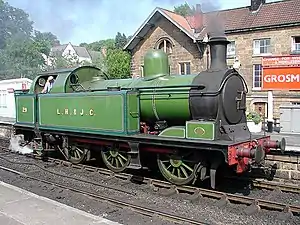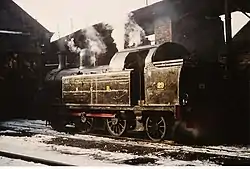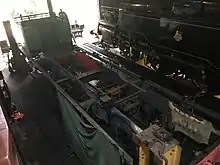LCR 29
Lambton Colliery Railway No.29 is a preserved 0-6-2 tank locomotive built by Kitson and Company for the Lambton Colliery network in 1904. It was the first 0-6-2T to be employed on that system, and it was later joined by No.5. No.29 was designed to work between Philadelphia and Sunderland. In February 1969, No.29 was withdrawn from service and placed into dead storage. The following year, the locomotive was purchased by volunteers from the North Yorkshire Moors Railway, and it was restored to working order. As of 2023, the locomotive remains operational on the NYMR.
| LCR No.29 | |||||||||||||||||||||||||||
|---|---|---|---|---|---|---|---|---|---|---|---|---|---|---|---|---|---|---|---|---|---|---|---|---|---|---|---|
 No.29 sitting at Grosmont station in 2006 | |||||||||||||||||||||||||||
| |||||||||||||||||||||||||||
| |||||||||||||||||||||||||||
| |||||||||||||||||||||||||||
| |||||||||||||||||||||||||||
History
Original service life
The Lambton Colliery was a privately owned colliery, in County Durham, England.[1] In the early 1900s, the company had a need for larger and more powerful locomotives than their existing 0-6-0 tender locomotives from the 1850s. In 1904, they approached Kitson and Company in Leeds, West Yorkshire, and they bought their first 0-6-2 tank locomotive, which was No.29.[2] 0-6-2 tank locomotives were previously introduced and proven their worth in hauling coal loads. With a tractive force of 23,500 pounds, as well as a boiler pressure of 165 pounds per square inch, the LCR decided to purchase two identical locomotives to No.29 for their roster in 1907, Nos 30 and 31. In 1909, two more 0-6-2s were bought by the LCR, Nos.5 and 10, but this time, by Robert Stephenson and Company with a slightly different design.[3] Two more 0-6-2s followed for the railway in 1920 and 1934, Nos.42 and 57. Some Ex Taff Vale Great Western Railway 0-6-2s would also soon follow.

No.29 and its classmates were used for shunting and pulling wagon loads of coal on LCR's rail lines, particularly between the pitheads near Philadelphia and the quayside coal staithes at Sunderland. In the late 1950s, (Under the ownership of the National Coal Board (NCB)) the Durham Coal field was being wound down, and a further spate of closures occurred in 1967 with Lambton Staithes being closed in January and the line to Pallion closing in August of the same year. The following year, the NCB was making steps to transition to diesel power, thus making the steam locomotives redundant even in the smaller railways of the country. In spite of an overhaul being completed in October 1968, No.29 was withdrawn only three months later on 15 February 1969, and it was placed into storage in Philadelphia shortly thereafter.
Preservation

In January 1970 three volunteers went to Philadelphia to examine Nos.5 and 29 with a view to purchase them. All the other withdrawn locomotives remained inside Philadelphia Works. During May, they were informed that their bids for Nos.5 and 29 had been successful, so they commenced preparing them for their journey to the North Yorkshire Moors Railway.[4] The initial plan was that the locomotive would be hauled by BR Class 46 diesel locomotive No.D186. However, the steam locomotive was allowed to haul the train to Thornaby, and when it arrived there, No.29 was fitted with a London, Midland and Scottish-style vacuum braking system from an LMS Class 5 4-6-0, and the left leading axlebox was re-metalled. Then, BR Class 37 No.D6899 hauled No.29, along with LNER Q6 No.63395, from Thornaby to the NYMR's main location in Grosmont. Under NYMR's ownership, No.29 has been restored to working order, and since the railway's reopening on 1 May 1973, it has been hauling rail tours on their rails, and over time, it was rotated in and out of service.[5] It was also given the name Peggy.[6] Having returned to steam after another overhaul for the 40th Anniversary of the NYMR in 2013, No.29 has been in frequent use until October 2014, when a crack was discovered in her cylinder block, and it was withdrawn to wait for a replacement block. Another overhaul was completed in July 2019 for the Annual Steam Gala. In July 2021, No.29 made an appearance at the Didcot Railway Centre in Didcot, Oxfordshire for that year's Diamond Jubilee Gala to celebrate the Great Western Society's 60th anniversary.[7] It is still available for traffic as of 2023.[8] It carries the LH&JC initials of the Lambton, Hetton and Joicey Colliery system, formed by various amalgamations in 1924.[2]
See also
References
- "Lambton Colliery". Durham Mining Museum. Retrieved 29 July 2023.
- "Brief History of the Lambton Railway". www.lambtonlocomotivestrust.co.uk. Retrieved 19 February 2021.
- "Robert Stephenson Works No 3377 No 5 0-6-2T". Preserved British Steam Locomotives. Retrieved 29 July 2023.
- "Lambton Colliery No. 29". North York Moors Historical Railway Trust - NYMR. 31 December 2019. Retrieved 24 February 2021.
- "Lambton Tank Returns To Steam In Time For Peak Rail Gala Visit". Steam Railway. No. 495. 26 July 2019. p. 11.
- "Kitson Works No 4263 29 Lambton Colliery 0-6-2T". Preserved British Steam Locomotives. 22 October 2017. Retrieved 25 February 2021.
- "Going Loco - July 2021 | Didcot Railway Centre". didcotrailwaycentre.org.uk. Retrieved 15 March 2022.
- Davies, Katie (8 September 2014). "Famous train will return to Tanfield Railway for the first time in more than four decades". ChronicleLive. Retrieved 12 February 2021.